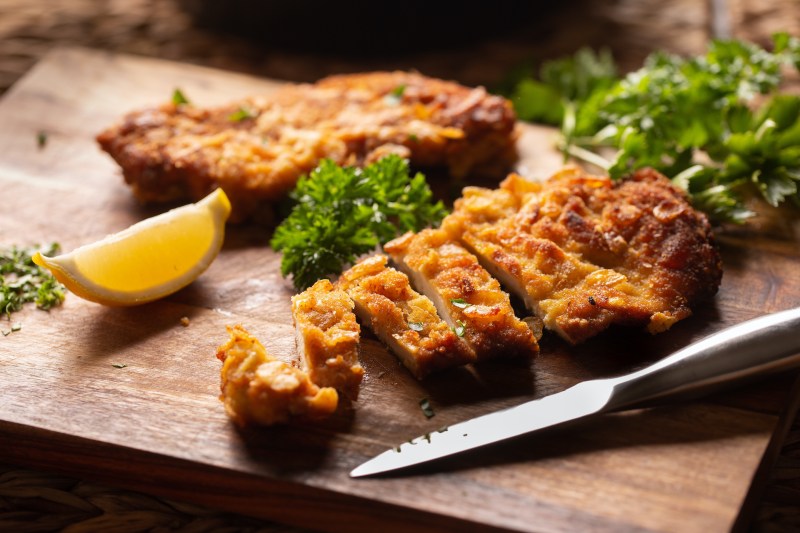
I have a confession to make to the mayonnaise-fearing people in my life. If you’ve ever eaten anything I’ve cooked that contains breaded chicken (and that’s many dishes), you’ve eaten – and likely very much enjoyed – mayonnaise. Look, I get it. A repulsion for mayonnaise is one of the most commonly heard culinary grievances, on par with a hatred for the word “moist.” Unfortunately, I have some bad news for people who have an aversion to both of these things. Mayonnaise is the secret to succulently moist chicken.
Traditional breaded chicken recipes call for three-step dredging stations of flour, egg, and breadcrumbs. While this is a tried and true method, the mayonnaise method is far better. By swapping mayo for flour and egg in the dredging process, you’re gifting yourself a far juicier and more flavorful dish. It’s also much simpler and makes less of a mess than dusty flour and runny eggs all over your clean kitchen countertops.
When one considers the ingredients that are actually in mayonnaise, this method makes perfect sense. After all, mayo is essentially just a mixture of egg and oil, so of course, mayonnaise is a great way to ensure deliciously juicy (and moist) chicken.
So whether you’re a mayonnaise lover like I am, or you suffer through life with a paralyzing fear of Hellmann’s, it’s time to up your chef game and embrace cooking chicken the right way.

Panko breaded chicken recipe
This delicious chicken recipe can be used in any dish that calls for breaded chicken. It’s perfect as a base for chicken parmesan, chicken schnitzel, or simply on its own next to roasted asparagus and buttery mashed potatoes.
Ingredients
Chicken
- 4 skinless, boneless chicken breast halves, pounded to 1/2-inch thickness
- Canola oil, for frying
- 4 tablespoons store-bought or homemade mayonnaise (recipe below)
- Juice from 1 lemon
- 1 1/2 cups panko breadcrumbs
- 1/4 cup freshly grated parmesan
- 1/2 teaspoon garlic powder
- 1/2 teaspoon onion powder
- 1/2 teaspoon smoked paprika
- Salt and pepper to taste
Mayonnaise
- 1 large egg, at room temperature
- 1 tablespoon Dijon mustard
- 1 tablespoon red wine vinegar
- 1 cup canola oil
- 1 teaspoon fresh lemon juice
- Salt to taste
Method
Mayonnaise
- In the bowl of a food processor, add egg and process for 20 seconds. Add the mustard, vinegar, and salt and process another 20-30 seconds.
- With the processor running, slowly drizzle in the oil in a small stream until the mixture starts to emulsify.
- When the mixture has emulsified, stream in the remaining oil and process for an additional 10-20 seconds.
- Season to taste.
Chicken
- In a medium dish, combine mayonnaise, lemon juice, salt, and pepper, whisking to combine thoroughly. Set aside.
- In another dish, combine panko, parmesan, garlic powder, onion powder, and smoked paprika, mixing to combine. Set aside.
- Pat chicken dry with paper towels, and dredge each piece evenly in the mayonnaise mixture, followed by the panko mixture, shaking off any excess breading.
- Heat a large nonstick skillet over medium-high heat and add 2 tablespoons of oil to the pan, swirling to coat.
- Saute each piece of chicken for 3 minutes on each side or until the chicken is done. Repeat with each piece of remaining chicken.
- Serve immediately.
Chicken cooking tips and tricks
- Pounding the chicken breasts is really an essential step that one shouldn’t skip when pan-frying. Chicken breasts are an odd, uneven shape, which means they won’t cook evenly unless pounded into an even layer. To avoid undercooked or overcooked spots, be sure to get an even layer.
- Regular breadcrumbs can absolutely be substituted for panko in this recipe, but we love the added crispiness from panko bread crumbs.
- Mixing parmesan in with the breadcrumbs is a great way to add beautiful caramelization and flavor to the chicken breast. This is a perfect way to use up the last bit of the parmesan rind you have in your cheese drawer.
- Depending on your recipe, feel free to add, subtract, or mix up the spices in this breading recipe. If you’re making chicken parmesan, for example, a few shakes of Italian seasoning would be delicious.
Editors' Recommendations
- NYC restaurant Mala Hot Pot teaches us about modern Chinese hot pot
- Drink up at these amazing bars — they’re favorites of famous authors
- How a Michelin-starred sushi chef crafts omakase to go
- Clams vs mussels: The differences explained
- How to dry fresh basil: 5 ways to preserve this essential herb




